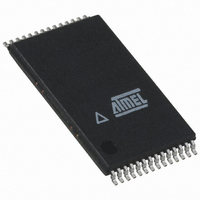AT45DB321D-TU Atmel, AT45DB321D-TU Datasheet - Page 7

AT45DB321D-TU
Manufacturer Part Number
AT45DB321D-TU
Description
IC FLASH 32MBIT 66MHZ 28TSOP
Manufacturer
Atmel
Specifications of AT45DB321D-TU
Format - Memory
FLASH
Memory Type
DataFLASH
Memory Size
32M (8192 pages x 528 bytes)
Speed
66MHz
Interface
SPI, RapidS
Voltage - Supply
2.7 V ~ 3.6 V
Operating Temperature
-40°C ~ 85°C
Package / Case
28-TSOP
Architecture
Sectored
Interface Type
SPI
Supply Voltage (max)
3.6 V
Supply Voltage (min)
2.7 V
Maximum Operating Current
15 mA
Mounting Style
SMD/SMT
Organization
528 B x 8192
Memory Configuration
8192 Pages X 528 Bytes
Clock Frequency
20MHz
Supply Voltage Range
2.7V To 3.6V
Memory Case Style
TSOP
Rohs Compliant
Yes
Lead Free Status / RoHS Status
Lead free / RoHS Compliant
Available stocks
Company
Part Number
Manufacturer
Quantity
Price
Part Number:
AT45DB321D-TU
Manufacturer:
ATMEL/爱特梅尔
Quantity:
20 000
6.4
6.5
3597O–DFLASH–10/09
Main Memory Page Read
Buffer Read
during the page boundary crossover (the crossover from the end of one page to the beginning of
the next page). When the last bit in the main memory array has been read, the device will con-
tinue reading back at the beginning of the first page of memory. As with crossing over page
boundaries, no delays will be incurred when wrapping around from the end of the array to the
beginning of the array. A low-to-high transition on the CS pin will terminate the read operation
and tri-state the output pin (SO). The Continuous Array Read bypasses both data buffers and
leaves the contents of the buffers unchanged.
A main memory page read allows the user to read data directly from any one of the 8,192 pages
in the main memory, bypassing both of the data buffers and leaving the contents of the buffers
unchanged. To start a page read from the DataFlash standard page size (528 bytes), an opcode
of D2H must be clocked into the device followed by three address bytes (which comprise the
24-bit page and byte address sequence) and 4 don’t care bytes. The first 13 bits (PA12 - PA0) of
the 23-bit address sequence specify the page in main memory to be read, and the last 10 bits
(BA9 - BA0) of the 23-bit address sequence specify the starting byte address within that page.
To start a page read from the binary page size (512 bytes), the opcode D2H must be
clocked into the device followed by three address bytes and 4 don’t care bytes. The first 13 bits
(A21 - A9) of the 22-bits sequence specify which page of the main memory array to read, and
the last 9 bits (A8 - A0) of the 22-bits address sequence specify the starting byte address within
the page. The don’t care bytes that follow the address bytes are sent to initialize the read opera-
tion. Following the don’t care bytes, additional pulses on SCK result in data being output on the
SO (serial output) pin. The CS pin must remain low during the loading of the opcode, the
address bytes, the don’t care bytes, and the reading of data. When the end of a page in
main memory is reached, the device will continue reading back at the beginning of the same
page. A low-to-high transition on the CS pin will terminate the read operation and tri-state the
output pin (SO). The maximum SCK frequency allowable for the Main Memory Page Read is
defined by the f
leaves the contents of the buffers unchanged.
The SRAM data buffers can be accessed independently from the main memory array, and utiliz-
ing the Buffer Read Command allows data to be sequentially read directly from the buffers. Four
opcodes, D4H or D1H for buffer 1 and D6H or D3H for buffer 2 can be used for the Buffer Read
Command. The use of each opcode depends on the maximum SCK frequency that will be used
to read data from the buffer. The D4H and D6H opcode can be used at any SCK frequency up to
the maximum specified by f
read operations up to the maximum specified by f
To perform a buffer read from the DataFlash standard buffer (528 bytes), the opcode must be
clocked into the device followed by three address bytes comprised of 14 don’t care bits and
10 buffer address bits (BFA9 - BFA0). To perform a buffer read from the binary buffer
(512 bytes), the opcode must be clocked into the device followed by three address bytes com-
prised of 15 don’t care bits and 9 buffer address bits (BFA8 - BFA0). Following the address
bytes, one don’t care byte must be clocked in to initialize the read operation. The CS pin must
remain low during the loading of the opcode, the address bytes, the don’t care byte, and the
reading of data. When the end of a buffer is reached, the device will continue reading back at the
beginning of the buffer. A low-to-high transition on the CS pin will terminate the read operation
and tri-state the output pin (SO).
SCK
specification. The Main Memory Page Read bypasses both data buffers and
CAR1
. The D1H and D3H opcode can be used for lower frequency
CAR2
.
AT45DB321D
7













